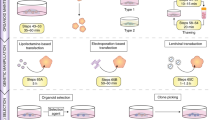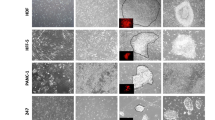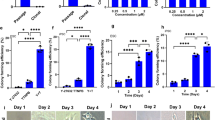Abstract
Historically, it has been difficult to propagate cells in vitro that are derived directly from human tumors or healthy tissue. However, in vitro preclinical models are essential tools for both the study of basic cancer biology and the promotion of translational research, including drug discovery and drug target identification. This protocol describes conditional reprogramming (CR), which involves coculture of irradiated mouse fibroblast feeder cells with normal and tumor human epithelial cells in the presence of a Rho kinase inhibitor (Y-27632). CR cells can be used for various applications, including regenerative medicine, drug sensitivity testing, gene expression profiling and xenograft studies. The method requires a pathologist to differentiate healthy tissue from tumor tissue, and basic tissue culture skills. The protocol can be used with cells derived from both fresh and cryopreserved tissue samples. As approximately 1 million cells can be generated in 7 d, the technique is directly applicable to diagnostic and predictive medicine. Moreover, the epithelial cells can be propagated indefinitely in vitro, yet retain the capacity to become fully differentiated when placed into conditions that mimic their natural environment.
This is a preview of subscription content, access via your institution
Access options
Access Nature and 54 other Nature Portfolio journals
Get Nature+, our best-value online-access subscription
$29.99 / 30 days
cancel any time
Subscribe to this journal
Receive 12 print issues and online access
$259.00 per year
only $21.58 per issue
Buy this article
- Purchase on Springer Link
- Instant access to full article PDF
Prices may be subject to local taxes which are calculated during checkout






Similar content being viewed by others
Change history
19 January 2018
In the version of this article initially published, elements of two references were inadvertently combined as reference 3; these are now listed separately as references 3 and 52. Both references are now cited wherever reference 3 was cited in the article. The error has been corrected in the HTML and PDF versions of the article.
06 April 2017
In the version of this article initially published, a middle initial was missing for one of the authors (Dean G. Tang). The error has been corrected in the HTML and PDF versions of the article.
References
Cunderlíková, B. Issues to be considered when studying cancer in vitro. Crit. Rev. Oncol. Hematol. 85, 95–111 (2013).
Kahn, J. et al. Preclinical models in radiation oncology. Radiat. Oncol. 7, 223–227 (2012).
Giard, D.J. et al. In vitro cultivation of human tumors: establishment of cell lines derived from a series of solid tumors. J. Natl. Cancer Inst. 51, 1417–1423 (1973).
Herrmann, D. et al. Three-dimensional cancer models mimic cell-matrix interactions in the tumour microenvironment. Carcinogenesis 35, 1671–1679 (2014).
Schmidt, F. & Efferth, T. Tumor heterogeneity, single-cell sequencing, and drug resistance. Pharmaceuticals (Basel) 9, 33 (2016).
Chapman, S. et al. Human keratinocytes are efficiently immortalized by a Rho kinase inhibitor. J. Clin. Invest. 120, 2619–2626 (2010).
Liu, X. et al. ROCK inhibitor and feeder cells induce the conditional reprogramming of epithelial cells. Am. J. Pathol. 180, 599–607 (2012).
Suprynowicz, F.A. et al. Conditionally reprogrammed cells represent a stem-like state of adult epithelial cells. Proc. Natl. Acad. Sci. USA 109, 20035–20040 (2012).
Watanabe, K. et al. A ROCK inhibitor permits survival of dissociated human embryonic stem cells. Nat. Biotechnol. 25, 681–686 (2007).
Terunuma, A. et al. Efficient procurement of epithelial stem cells from human tissue specimens using a Rho-associated protein kinase inhibitor Y-27632. Tissue Eng. Part A 16, 1363–1368 (2010).
Rheinwald, J.G. & Green, H. Serial cultivation of strains of human epidermal keratinocytes: the formation of keratinizing colonies from single cells. Cell 6, 331–343 (1975).
Yue, J. et al. Cutaneous human papillomavirus type 38 E7 regulates actin cytoskeleton structure for increasing cell proliferation through CK2 and the eukaryotic elongation factor 1A. J. Virol. 85, 8477–8494 (2011).
Charette, S.T. & McCance, D.J. The E7 protein from human papillomavirus type 16 enhances keratinocyte migration in an Akt-dependent manner. Oncogene 26, 7386–7390 (2007).
Yuan, H. et al. Use of reprogrammed cells to identify therapy for respiratory papillomatosis. N. Engl. J. Med. 367, 1220–1227 (2012).
Prater, M.D. et al. Mammary stem cells have myoepithelial cell properties. Nat. Cell Biol. 16, 942–950 (2014).
Walters, B.J. et al. Pseudo-immortalization of postnatal cochlear progenitor cells yields a scalable cell line capable of transcriptionally regulating mature hair cell genes. Sci. Rep. 5, 17792 (2015).
Hata, A.N. et al. Tumor cells can follow distinct evolutionary paths to become resistant to epidermal growth factor receptor inhibition. Nat. Med. 22, 262–269 (2016).
Garraway, L.A Lander E.S. Lessons from the cancer genome. Cell 153, 17–37 (2013).
Brown, D.D. et al. Developing in vitro models of human ductal carcinoma in situ from primary tissue explants. Breast Cancer Res. Treat. 153, 311–21 (2015).
Boehm, J.S. & Golub, T.R. An ecosystem of cancer cell line factories to support a cancer dependency map. Nat. Rev. Genet. 16, 373–4 (2015).
Chu, H.W. et al. CRISPR-Cas9-mediated gene knockout in primary human airway epithelial cells reveals a proinflammatory role for MUC18. Gene Ther. 22, 822–9 (2015).
Friedman, A.A. et al. Precision medicine for cancer with next-generation functional diagnostics. Nat. Rev. Cancer 15, 747–56 (2015).
Crystal, A.S. et al. Patient-derived models of acquired resistance can identify effective drug combinations for cancer. Science 346, 1480–1486 (2014).
Beglyarova, N. et al. Screening of conditionally reprogrammed patient-derived carcinoma cells identifies ERCC3-MYC interactions as a target in pancreatic cancer. Clin. Cancer Res. 22, 6153–6163 (2016).
Saeed, K. et al. Comprehensive drug testing of patient-derived conditionally reprogrammed cells from castration-resistant prostate cancer. Eur. Urol. http://dx.doi.org/10.1016/j.eururo.2016.04.019 (2016).
Veit, G. et al. Ribosomal stalk protein silencing partially corrects the ΔF508-CFTR functional expression defect. PLoS Biol. 14, e1002462 (2016).
Butler, C.R. et al. Rapid expansion of human epithelial stem cells suitable for airway tissue engineering. Am. J. Respir. Crit. Care Med. 194, 156–168 (2016).
Thangapazham, R.L. et al. Dissociated human dermal papilla cells induce hair follicle neogenesis in grafted dermal-epidermal composites. J. Invest. Dermatol. 134, 538–540 (2014).
Thangapazham, R.L. et al. A model system to analyse the ability of human keratinocytes to form hair follicles. Exp. Dermatol. 23, 443–446 (2014).
Jin, K. et al. Patient-derived human tumour tissue xenografts in immunodeficient mice: a systematic review. Clin. Transl. Oncol. 12, 473–480 (2010).
Fulcher, M.L. & Randell, S.H. Human nasal and tracheo-bronchial respiratory cell culture. Methods Mol. Biol. 945, 109–121 (2013).
Ali, S.H. & DeCaprio, J.A. Cellular transformation by SV40 large T antigen: interaction with host proteins. Semin. Cancer Biol. 11, 15–23 (2001).
Shay, J.W. & Wright, W.E. Senescence and immortalization: role of telomeres and telomerase. Carcinogenesis 26, 867–874 (2005).
Wilding, J.L. & Bodmer, W.F. Cancer cell lines for drug discovery and development. Cancer Res. 74, 2377–2384 (2014).
Wright, W.E. & Shay, J.W. The two-stage mechanism controlling cellular senescence and immortalization. Exp. Gerontol. 27, 383–389 (1992).
Curry, E.L. et al. Using induced pluripotent stem cells as a tool for modelling carcinogenesis. World J. Stem Cells 7, 461–469 (2015).
Seki, T. & Fukuda, K. Methods of induced pluripotent stem cells for clinical application. World J. Stem Cells 7, 116–125 (2015).
de Miguel-Beriain, I. The ethics of stem cells revisited. Adv. Drug Deliv. Rev. 82–83, 176–180 (2015).
Chen, G. et al. Chemically defined conditions for human iPSC derivation and culture. Nat. Methods 8, 424–429 (2011).
Williams, S.A. et al. Patient-derived xenografts, the cancer stem cell paradigm, and cancer pathobiology in the 21st century. Lab. Invest. 93, 970–982 (2013).
Tentler, J.J. et al. Patient-derived tumour xenografts as models for oncology drug development. Nat. Rev. Clin. Oncol. 9, 338–350 (2012).
Boone, J.D. et al. Ovarian and cervical cancer patient derived xenografts: the past, present, and future. Gynecol. Oncol. 138, 486–491 (2015).
Bernardo, C. et al. Patient-derived bladder cancer xenografts: a systematic review. Transl. Res. 166, 324–331 (2015).
Boj, S.F. et al. Organoid models of human and mouse ductal pancreatic cancer. Cell 160, 324–338 (2015).
van de Wetering, M. et al. Prospective derivation of a living organoid biobank of colorectal cancer patients. Cell 161, 933–945 (2015).
Sachs, N. & Clevers, H. Organoid cultures for the analysis of cancer phenotypes. Curr. Opin. Genet. Dev. 24, 68–73 (2014).
Li, X. et al. Oncogenic transformation of diverse gastrointestinal tissues in primary organoid culture. Nat. Med. 20, 769–777 (2014).
Nadauld, L.D. et al. Metastatic tumor evolution and organoid modeling implicate TGFBR2 as a cancer driver in diffuse gastric cancer. Genome Biol. 15, 428 (2014).
Drost, J. et al. Sequential cancer mutations in cultured human intestinal stem cells. Nature 52, 43–47 (2015).
Palechor-Ceron, N. et al. Radiation induces diffusible feeder cell factor(s) that cooperate with ROCK inhibitor to conditionally reprogram and immortalize epithelial cells. Am. J. Pathol. 183, 1862–1870 (2013).
McAuliffe, P.F. et al. Cancer xenografts is enhanced in chemoresistant disease and predicts poor patient outcomes. PLoS One 10, e0136851.
Gillet, J.P., Varma, S. & Gottesman, M.M. The clinical relevance of cancer cell lines. J. Natl. Cancer Inst. 105, 452–458 (2013).
Acknowledgements
Studies of conditional cell reprogramming were funded predominantly by internal funds from the Center for Cell Reprogramming at Georgetown University Medical Center and grants R33CA177466, R21CA180524 and R01RR032315 from the National Institutes of Health. We thank A. Wellstein, P. Furth, A. Riegel and B. Haddad for valuable discussions during the course of this study.
Author information
Authors and Affiliations
Contributions
E.K., S.A., F.A.S., X.L. and R.S. wrote the paper and all other authors provided substantial editorial revisions. Representative experiments on the prostate were designed or performed by O.T., A. Dritschilo, C.A., D.T., X.L. and R.S. Similar contributions by E.K., C.A., X.L., S.C. and R.S. were made with regard to pancreas, colon and neuroendocrine tumors. Skin experiments involved T.D., R.T., X.L. and R.S. Lung experiments involved S.H.R., X.L. and R.S. GIST experiments involved E.K., X.L. and R.S. Procedure for irradiation involved A. Dakic, V.S. and X.L. Procedure for CM involved N.P.-C. and X.L.
Corresponding authors
Ethics declarations
Competing interests
Georgetown University has been awarded a patent by the United States Patent Office (9,279,106) for conditional cell reprogramming. This technology has been licensed exclusively to a biotechnology company, Propagenix, for commercialization. Georgetown University and the inventors (X.L., R.S.) receive payments and potential royalties from Propagenix.
Integrated supplementary information
Supplementary Figure 1 Real-time assessment of endothelial cell monolayer disruption by CR normal and tumor cells.
An xCELLigence real-time cell analysis (RTCA) instrument was used to measure the invasion of CR normal and tumor cells for a period of 11 hours. A continuous steady decrease in cell index was observed for CR tumor cells (green) compared to CR normal cells (red). Details of the method may be found in: Limame, R. et al. Comparative analysis of dynamic cell viability, migration and invasion assessments by novel real-time technology and classic endpoint assays. PLoS One 7, e46536 (2012).
Supplementary information
Movement of cilia in tracheal–bronchial CR cells.
Time-lapse imaging showing synchronized movement of cilia in differentiated tracheal–bronchial CR cells at 4× normal time. Scale bars: 30 μm. Details of the method may be found in Rock, J.R. et al. Basal cells as stem cells of the mouse trachea and human airway epithelium. Proc. Natl. Acad. Sci. USA. 106, 12771–12775 (2009). Tissue specimens were collected with the informed consent of patients according to University of North Carolina School of Medicine Institutional Review Board protocols. (MOV 7329 kb)
Formation of epithelial cell colonies in CR culture.
Time-lapse imaging showing proliferation and rapid merging of epithelial cell colonies in coculture with irradiated J2 cells at 27,000× normal time. Scale bars: 30 μm. Human tissue specimens were collected with the informed consent of patients according to Georgetown University Institutional Review Board protocols. (MOV 9320 kb)
Rights and permissions
About this article
Cite this article
Liu, X., Krawczyk, E., Suprynowicz, F. et al. Conditional reprogramming and long-term expansion of normal and tumor cells from human biospecimens. Nat Protoc 12, 439–451 (2017). https://doi.org/10.1038/nprot.2016.174
Published:
Issue Date:
DOI: https://doi.org/10.1038/nprot.2016.174
This article is cited by
-
The heterogeneity of signaling pathways and drug responses in intrahepatic cholangiocarcinoma with distinct genetic mutations
Cell Death & Disease (2024)
-
Establishment and characterization of a novel hypopharyngeal squamous cell carcinoma cell line CZH1 with genetic abnormalities
Human Cell (2024)
-
Inhibition of BMP signaling pathway induced senescence and calcification in anaplastic meningioma
Journal of Neuro-Oncology (2024)
-
A biomimetic nanoplatform for customized photothermal therapy of HNSCC evaluated on patient-derived xenograft models
International Journal of Oral Science (2023)
-
Novel inhibition of AKR1C3 and androgen receptor axis by PTUPB synergizes enzalutamide treatment in advanced prostate cancer
Oncogene (2023)
Comments
By submitting a comment you agree to abide by our Terms and Community Guidelines. If you find something abusive or that does not comply with our terms or guidelines please flag it as inappropriate.



